Event Reports for 2006
Winter Activity - RSPB Garden Birdwatch (28th & 29th January) - John Jackson and Nigel Heriz-Smith promoted participation in this annual event. For those with school aged children: There is also an RSPB "Big Schools' Birdwatch 2006" (23rd January to 3rd February) supported by a teacher's pack.
1st February - The National Fruit Collection at Brogdale
The National Fruit Collection at Brogdale
- A talk given by Peter Griffiths.
Brogdale's Apple Collection is catalogued and illustrated through their search facility and you can make a stab at identifying your own apples through their web pages.
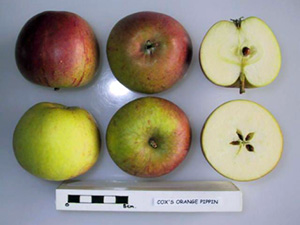 The evening of February 1st was bitterly cold with sub-zero temperatures and a north-easterly gale blowing. This resulted in a smaller audience than usual turning up at Lynsted with Kingsdown Society's talk on the National Fruit Collection at Brogdale in Greenstreet Methodist Hall. Those who did brave the elements were rewarded by an informative and entertaining account of the developing history of the fruit collection by senior guide, Peter Griffiths.
The evening of February 1st was bitterly cold with sub-zero temperatures and a north-easterly gale blowing. This resulted in a smaller audience than usual turning up at Lynsted with Kingsdown Society's talk on the National Fruit Collection at Brogdale in Greenstreet Methodist Hall. Those who did brave the elements were rewarded by an informative and entertaining account of the developing history of the fruit collection by senior guide, Peter Griffiths.
The collection of fruit and fruit trials at Brogdale was started a long while ago but has only been open to the public since the 1950s. It is a unique collection of fruit with the majority of species being apples.
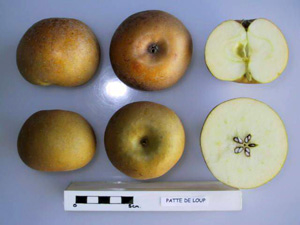 Despite the fact that it was mid-winter, Peter had managed to collect examples of several different apples, some picked from the trees that day, of various sizes and shapes, to illustrate his talk. Some of the apples were familiar (e.g. Cox's Orange Pippin, Bramley's Seedling, Granny Smith etc.) Others were strangely coloured or very small or possessed unusual names such as Patte du Loup (claw of the wolf - so called because each apple had a circular scar on it). We were surprised to learn that, in Victorian times, the apple was quite a status symbol with heads of households competing to serve their guests the latest, new variety of apple! This encouraged the development of many new types and there are now 2300 different varieties of apples growing at Brogdale. Global warming will continue to create a demand for further varieties that thrive in warmer, drier conditions.
Despite the fact that it was mid-winter, Peter had managed to collect examples of several different apples, some picked from the trees that day, of various sizes and shapes, to illustrate his talk. Some of the apples were familiar (e.g. Cox's Orange Pippin, Bramley's Seedling, Granny Smith etc.) Others were strangely coloured or very small or possessed unusual names such as Patte du Loup (claw of the wolf - so called because each apple had a circular scar on it). We were surprised to learn that, in Victorian times, the apple was quite a status symbol with heads of households competing to serve their guests the latest, new variety of apple! This encouraged the development of many new types and there are now 2300 different varieties of apples growing at Brogdale. Global warming will continue to create a demand for further varieties that thrive in warmer, drier conditions.
As well as the history of the apple collection, examples of quince (as mentioned in the ‘Owl and the Pussycat'!) and medlars were also passed around the audience who were treated to several, amusing anecdotal stories of their history.
At the end off his talk Peter produced bags of apples and bottles of apple juice for us to sample and buy. We are indeed fortunate to live just three miles from this historic collection of fruit and I, for one, will look around with wider eyes when I next visit Brogdale.
Norma Baxter
10th February - Bat Group - Review.
A meeting with Shirley Thompson, of the Kent Bat Group - in the Lynsted Church Community Room. Call for more volunteers too. Orchard bat survey results discussed at a meeting of the Bat Group
Shirley Thompson of the Kent Bat Group joined us in the Community Room on 10th February, for a discussion about the results of last summer's survey of bat activity in Lynsted's Community Cherry Orchard. It was something of a ‘joint' session: although organised by the Orchard Group, and using sonic detector boxes procured by the Group, most of the dozen volunteer ‘surveyors' were Lynsted with Kingsdown Society members! And a few additional members joined in the discussion.
Shirley was very pleased at the level of enthusiasm in the subject, and the effort put in by all. She explained that bat numbers in Britain had dropped in recent years (a point echoed by Lynsted residents). She said that remarkably little was known about the detailed behaviour of bats, and so our weekly ‘counts' were a useful contribution.
In summary, the findings were: the most common bat was the Pipistrelle (the bat boxes detected two species), but a larger species, probably the Noctule, was occasionally detected at the valley end of the Orchard. Activity/numbers flying were greater between May and September. This would coincide with the use of maternity roosts first by pregnant, and later by lactating females with young. This indicated the importance of the Orchard as a foraging area, at critical periods, for a roost nearby. There was more activity on warmer evenings. Surprisingly, there was no greater activity when the blossom was out or during fruiting – when more insects (the bats' prey) would have been attracted. The Pipistrelles seemed to prefer flying in the gaps between the cherry trees, and were more often detected in the northern sectors of the Orchard. We intend to present the summarised data in a report in due course.
There was much enthusiasm for doing more, and future work could include more definite species identification, tracking the direction of movement, surveying over a larger area, ‘bat watch evenings' and locating the place where the bats roost during the day.
Bob Baxter
15th March - Ancient Farm Buildings
- A talk give by Ray Harrison (retired Architectural Conservation Officer).
The Kentish barn: the functional heart of the farm
The persistent cold and miserable weather did not deter thirty members and friends of the Lynsted with Kingsdown Society from attending a fascinating illustrated talk about Kentish barns on 15th March. Ray Harrison, a Faversham-based conservation architect, shared his enthusiasm and great knowledge of his subject as he took his audience through the history and function of the rural barn.
We learned that the barn, being a place where grain was threshed from the harvested cereals or pulses, and stored away, was a ‘prestige' building. It was erected close to the farmhouse to proclaim the farmer's wealth. Ray explained that the barn was an early, and very functional, structure in the evolution of farm buildings. Often there was a stock enclosure attached, so that over-wintered beasts could be conveniently fed from the stored crops. The dung would be spread on the fields, providing nutrients for the following crop, and completing a never-ending cycle.
All barns have the same basic structure: pairs of large doors opposite each other, with storage bays on each side. The through-draft aided the ‘winnowing' of grain from straw as the sheaves were threshed on the threshing floor. A ‘threshhold' of planks would keep the grain in place prior to bagging.
Ray illustrated the development of the barn, from a timber-framed, often aisled, building with a thatched roof, through wooden walled, slab-sided structures coated with tar, to brick walled barns with gable ends and tiled roofs. Along the way, modifications were often made to allow access for animal- and then steam-driven threshing machines.
Sadly, but inevitably, barns are going out of use, and those that are modified for residential or office use have their original structural features hidden by floors and partitions.
Ray's detailed answering of questions (mainly from occupiers of barn conversions!) rounded off a very enjoyable and informative evening.
Bob Baxter.
29th April - Guided walk around Doddington
Buzzards and Buttercups - Doddington and Sharsted
- walk led by Richard Moyse Senior Conservation Officer from the Kent Wildlife Trust
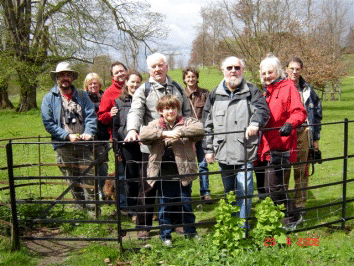 An account of our enjoyable and informative 4 mile walk in the Doddington area.
An account of our enjoyable and informative 4 mile walk in the Doddington area.
Walking Group around Doddington and Sharsted. A fine, sunny, late- April Saturday morning found a group of Lynsted with Kingsdown Society members (plus two young children and two well-behaved dogs) in Doddington Church car-park, eagerly waiting to set out on a Spring Walk. While our walking boots were still clean we had a guided tour around Doddington Church and environs where, our guide, Richard Moyse, is responsible for managing the churchyard for wildlife. We then set out across Doddington Parkland and headed for Sharsted Court. As we walked we stopped frequently so that Richard could explain about the various woodland plants and birds that we spied. After this cold winter it was reassuring to see that signs of spring were to be seen all around us. As well as the usual wood anemones, primroses, wood violets and bluebells we found examples of the less common cuckoo flower, Townhall clock, mistletoe, Goldilocks buttercup and also, growing on some tree roots, the parasitic toothwort. As we left Sharsted we were also lucky enough to hear and see a lesser-spotted woodpecker.
Emerging into The Street at Newnham we crossed over to Newnham churchyard and continued up Seed Road before crossing country again to wander through woodland back to Doddington Park. On our way back we stopped several times simply to listen to the birdsong as the birds called to each other and flew from tree to tree searching for food for their hungry offspring.
As we reached the final stile, before returning through Doddington Park once more, we were stopped by the clear, ringing whistle of a nuthatch which had perched on a bough just above our heads and was clearly visible to all. As we watched this colourful, perky little bird a pair of buzzards soared above our heads making an appropriately dramatic finale to a Bank Holiday Saturday morning.
Our particular thanks to Richard Moyse for making this walk along local footpaths in an ‘Area of Outstanding Natural Beauty', such an enjoyable and informative experience.
Norma Baxter
1st July - Bus Trip to Ramsgate.
Pugin in Ramsgate & Shell Grotto.
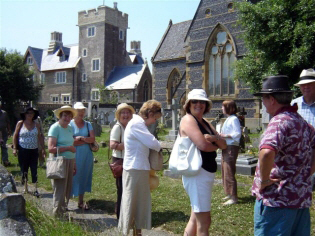

A members' visit to Thanet in vintage Titan bus (thanks to David Powell). Picnic lunch at St. Augustine before a visit to Ramsgate for a guided tour by Catriona Blaker around buildings designed by Pugin. The bus returned via the Shell Grotto.
Twenty enthusiasts gathered in the dappled shade on 1st July to board David Powell's grand old vintage Leyland double-decker. Our first destination was the mysterious Shell Grotto in a back street in Margate. Upper deck passenger gasped as David threaded his huge ‘green machine' between lampposts and amazed car drivers to reach a convenient parking space.
The Grotto Ramsgate
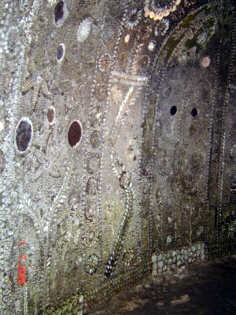
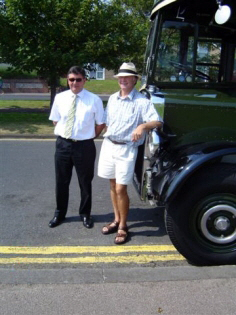
The Grotto was impressive: 2000 sq. ft. of local sea shells arranged in elaborate patterns on the walls of an underground system of passages and rooms. Prehistoric tomb? Knights Templars' shrine? Eighteenth century ‘folly'? Our excellent guide could not say. English Heritage was apparently baffled. A well laid out shop and coffee facility added to the enjoyment of this puzzling, striking, place.
It was then on to the spacious Esplanade in Ramsgate for a picnic in the sunshine, before joining Catriona Blaker of the Pugin Society, for the story of the Pugin family and an informative tour of the St Augustine's chapel. This fine church was designed, and paid for, by Augustus Pugin, who had become famous for his internal designs at the Houses of Parliament. Augustus was a keen convert to Catholicism and initiated the nineteenth century Gothic Revival movement. The chapel displayed the subdued magnificence of early Victorian architecture and crafts, including fine building in knapped flint and limestone, elaborate ironwork and beautiful stained glass. Everything displayed the ‘art with function' philosophy of this pioneer of the Arts and Crafts way of thinking. Catriona reminded us that his son Edward had designed our church in Kingsdown.
By this time feet were beginning to throb, and the decision was made to omit the intended visit to the Spitfire and Hurricane Museum on this occasion, and head home. We arrived back in Lynsted, tired but happy, after a thoroughly enjoyable ‘day out'.
Bob Baxter, Chairman
16th September - Lichens on Gravestones.
Lynsted Churchyard Lichens
Keith Palmer spoke for an hour, followed by practical description of the lichens in Lynsted churchyard.
They are everywhere to be seen, but so often overlooked or dismissed as ‘part of the background' but hardly "interesting". Society members were treated to an education on just how much we have been missing.
Keith Palmer, our guest speaker and guide, explained that lichen are actually two plants - a fungus joined together with an alga ("mutualism" - a form of symbiosis in which both parts benefit). If you look very carefully at a cross-section, we learned that you can often see layers of fungus and alga. Lichens (pronounced with a hard "k" by those in the know!) can be found where ever they can gain a purchase - on trees, fences, weathered rocks and gravestones, even rusting metal and plastic bin lids!
Harmless - the weathering happened first, so don't make the mistake of thinking that lichens cause deterioration in the gravestones. Nutrients are delivered by being dissolved in rain, and bird droppings together with photosynthesis. If you feel you must clean a tombstone to read an inscription, do so sparingly. Leave some lichen so it can continue to grow.
Breath deeply - Lichens are important because they tell you something about the quality of the air around us - in highly polluted towns (and in Victorian times when coal fired everything), lichens die. The rarest lichens need the kind of pure air you find in such places as Scotland or the Pacific seaboard of Canada! Lynsted was last surveyed in 1989 by Keith Palmer, when he found 25 varieties. Although he believes that a more detailed survey could uncover many more than this.
Keith's talk was supported by a range of slides to help us understand the different types of lichen:
- leprose (powdery, random, simple) - his first example was green
- crustose (crusty)
- foliose (leaflike, reminds you a bit of seaweed; you can easily put your finger-nail under this lichen) - examples include xanthora, found on top of gravestones and farm buildings.
- fruticose (shrubby; single "holdfast") - this is the most pollution-sensitive type and more likely to occur in Scotland. The examples shown were extraordinarily beautiful - a spike-shaped Cladonia and some with cups ontop! Occasionally found in rockeries.
Reproduction - Keith explained that lichen reproduction can be fairly random. Sometimes relying on spores being dislodged as soredia (powdery dust) by rain, slugs, or snails, from fruiting bodies - such as happens with Caloplaca flavescens (orange/golden, radiating lobes, fruiting bodies showing as dots to the naked eye). These fruiting bodies are often deeper in colour than the edge of the lichen, because the lighter edge is where the younger lichen growth is, which is not ready to fruit. Typically, a lichen grows around 1 milimeter per year (although the foliose ones can grow by up to 1 centimetre and year).
Identification - Keith told us that some can be identified by taste (bitter - not to be recommended except for identification purposes!). For the most part you have to get down and personal with a magnifying glass and particular chemicals to help identification. Although the Cyphelium has black spots that leave black dust on your fingertips if you touch them. The Graphis scripta has a very distinctive "squiggly" lichen (a bit like handwriting) that forms on trees. Finally, Keith pointed to an Eagles Claw lichen - no prizes for guessing what shape the edges were of this lichen. If you want a good field guide to help with the more than one-hundred lichens on offer, Keith recommended a prolific specialist writer - Frank S. Dobson - "An Illustrated Guide to the British and Irish Species" (published by The Richmond Publishing Company); or the out of print Observer Book of Lichens. Better still, attend a course through the Field Studies Council.
So, what did we find in a short guided tour of a few tombstones in Lynsted churchyard?
We have produced a Gallery of Images here of the examples we found.
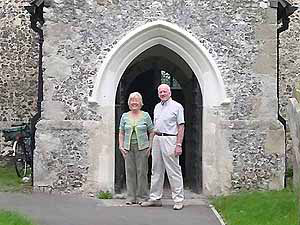 |
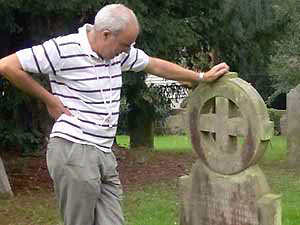 |
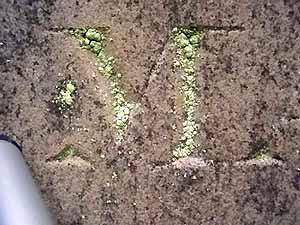 |
| 1. Society Welcome Bob and Norma offer a Society welcome for a mixture of presentation and field-work that offered surprising insights into the beauty of lichens. |
2. Keith Palmer & Psilolechia Our day was introduced with slides and an informative talk before we repaired to the churchyard and a simple green lichen with a not-so-simple name! |
3. Psilolechia lucida Keith had explained that this lichen often acted to enhance the lettering on memorials by colonising the crevices as in this case. The "M" of Mary Maytum. |
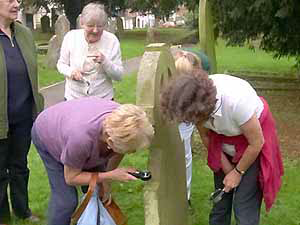 |
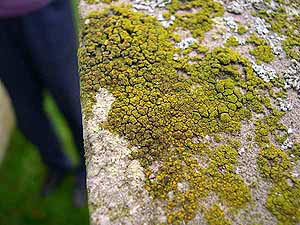 |
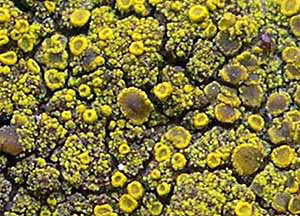 |
| 4. Enthusiasm of members Under Keith's direction the Members (which included a couple of children) were soon getting up close and personal with memorials and tombstones. |
5. Candelariella This lichen occupies horizontal surfaces that benefit from nutrients like bird droppings |
6. Fruiting bodies Keith Palmer explained that many fruiting bodies look like "jam tarts" with different coloured fillings. Magnification is needed to appreciate this feature. |
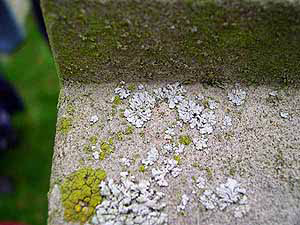 |
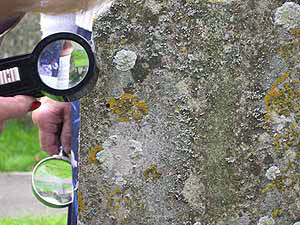 |
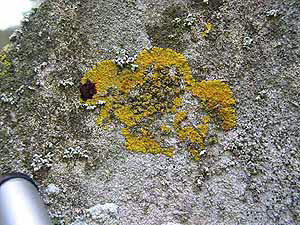 |
| 7. Physcia - light grey Lichens are so often dismissed as dull. Grey doesn't help draw your attention, but close inspection reveals complex structures. |
8. Caloplaca flavescens The yellow caloplaca is confirmed by the application of potassium hydroxide - the red dot |
9. Potassium Hydroxide Close up of the test that confirms this identification |
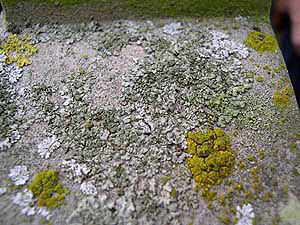 |
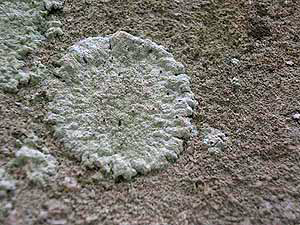 |
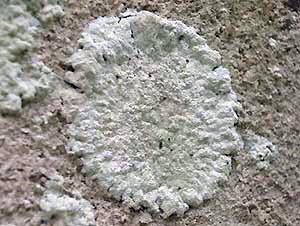 |
| 10. Physcia orbicularis A close up of another fascinating complex shape and fruiting body |
11. Diploicia canescens This is common throughout the graveyard. Rather 'crater like', showing a radiating form |
12. Diploiscia in relief A close up that reveals how proud of a surface a lichen can appear |
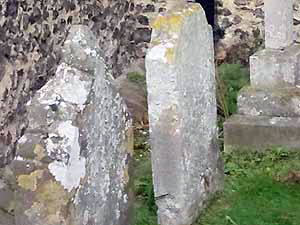 |
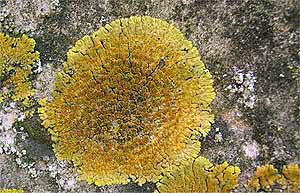 |
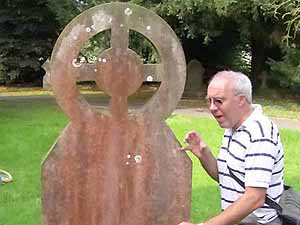 |
| 13. Caloplaca in situ Keith declared this a particular favourite of his. It can be noted that we had not yet moved from the shadow of the porch, and found a wide variety of lichens on display. |
14. Radiating and lobed Caloplaca A neat example of lichen form. The more mature center is darker, supporting fruiting bodies, while the outer rim is younger and lighter. These lichen spread about 1 milimeter per year |
15. Lichen = fungus + Alga Trentopohlia alga can exist without the fungus, but the fungus cannot exist without the alga. The red stain is the alga, waiting to be populated by spores landing on it - "mutualism". |
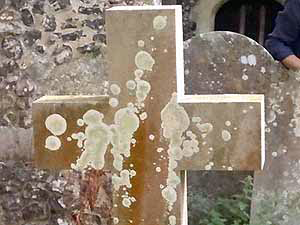 |
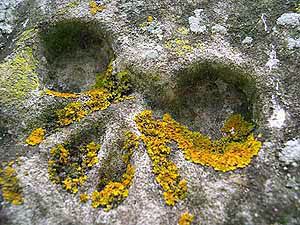 |
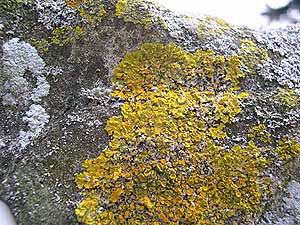 |
| 16. Alga and Lichen Another example of the dependency of lichens on alga |
17. Xanthora - leafy form The only foliate lichen we found in the graveyard. In case you wondered, yes these are the eyes of a skull carving. |
18. Xanthora on exposed surface Foliate lichens indicate cleaner air - so we should take this as being encouraging. |
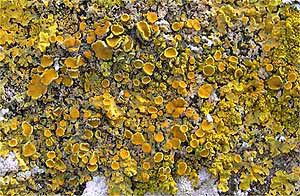 |
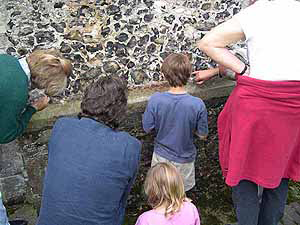 |
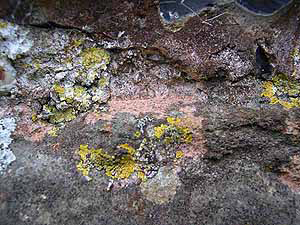 |
| 19. Xanthora close up | 20. Inspecting the ragstone ledge | 21. Belonia nidarosiensis - a characteristic pink hue |
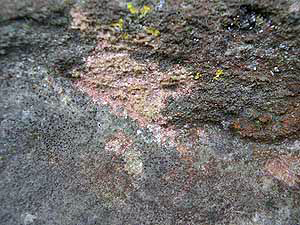 |
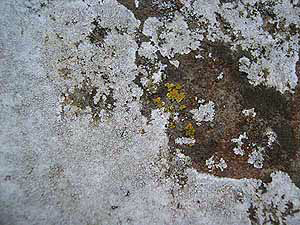 |
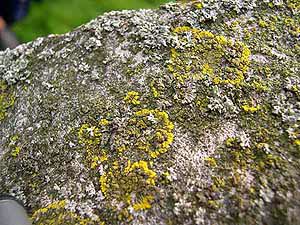 |
| 22. Belonia nidarosiensis Another detail of lichen on the ragstone base |
23. Aspicilia calcarea A white powdery mass that colonises much of the ragstone ledge. |
24. Lecanora campestris |
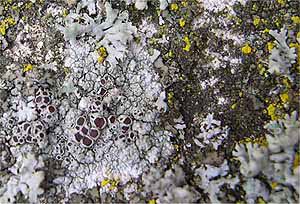 |
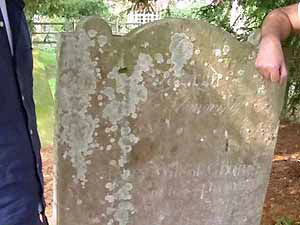 |
|
| 25. Lecanora campestris close up Note the fruiting bodies, Keith describes these as "jam tarts" as a way of reminding his students! |
26. Yew trees are not lichen friendly This tombstone is unusual in that is sits under a yew and is the only one in this position to have lichens on it. Yews are generally hostile to lichens. |
|
27th October - AGM and Underground Kent
A fascinating talk ranging from deneholes to nuclear bunkers given by Rod LeGear and explaining the truth behind several myths. This presentation followed a brief AGM (REPORT).
